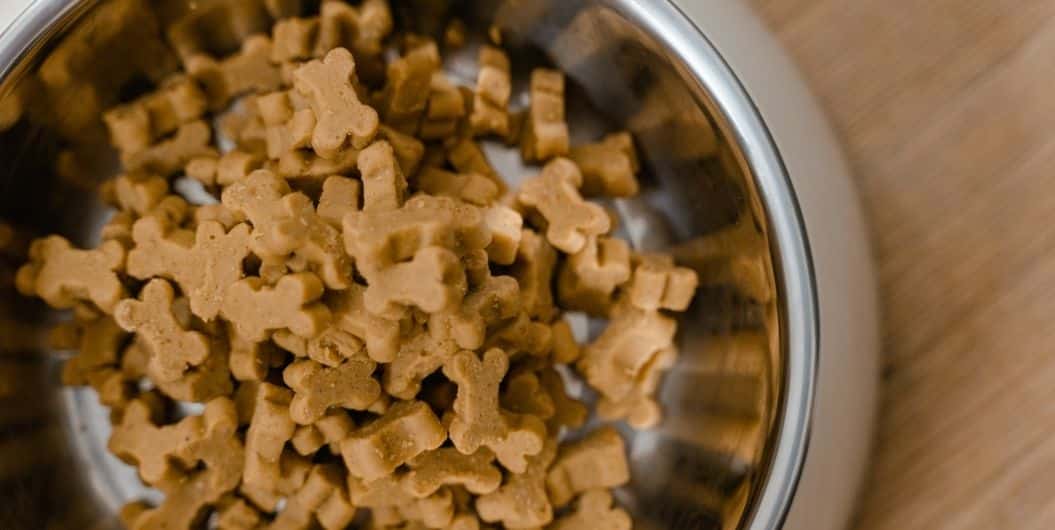What Should I Consider When Buying Healthy Dog Food?

There is nothing healthier for your dog than eating fresh, whole foods chosen from the same shelves from which you choose your own foods. After all, there is no such thing as dog food, only food. The fresher and less processed the food, the better. If you prefer to buy prepared foods, there may be trade offs when it comes to your dog’s health.
Diseased, disabled, dying or dead livestock, known as 4-D livestock, commonly find its way into commercial dog food as a cheap source of protein. The US government requires 4-D meat be “denatured” with harmful chemicals before leaving slaughterhouses to prevent the meat from being marketed. These diseased, chemically treated carcasses are sold to rendering plants.
Rendering plants are not controlled by government oversight and legally render all kinds of animals, including roadkill and euthanized pets picked up from veterinarian’s offices. Sodium pentobarbitol used by veterinarians to kill pets survives the rendering process. The final rendered product is sold to various industries, including the pet food industry, to serve as the basis for animal fat and meat and bone meal in many brands of pet food.

The Pet Food Institute (PFI) that manufactures the vast majority of dog food sold in the United States claims to use livestock rendering plants that do not render pets. However, in 2002 the Food and Drug Administration’s director of the Center for Veterinary Medicine (CVM), Stephen Sundloff, found low amounts of sodium pentobarbitol in dog food. The problem may be that rendering plants are only as good as their word, as there is nothing illegal in rendering pets, or selling pet-rendered product.
It is not cost-effective for a rendering plant to prepare every carcass thrown into a rendering vat. Metal livestock tags, pet tags, and veterinarian needles are a few of the possible reasons given for the sometimes significant amounts of lead found in commercial dog food. Flea collars and fish poisoned with illegal uses of DDT might account for pesticides found, and Styrofoam™ with plastic wrap is also added to vats from outdated, packaged grocery meats. Plastic bags used at veterinarian’s offices to transfer dead pets to holding freezers are also routinely thrown in vats with their contents, as it is too time consuming to open each bag.
Stabilizers used to preserve rendered product are also troublesome, linked to liver and kidney disease. These preservatives include butylated hydroxyanisole (BHA) and butylated hydroxytoluene (BHT). You might also see ethoxyquin listed on pet food labels, a possible carcinogen, or propylene glycol, a chemical closely related to anti-freeze.
Despite growing evidence to the contrary, the pet food industry and even the FDA maintains that dog food is healthy, and indeed it meets minimal requirements as set by the Association of American Feed Control Officials (AAFCO). This standard ensures the product contains important nutrients to meet your dog’s needs. Many veterinarians promote commercial dog food by selling it at their offices, and firmly stand behind the dog food industry. But not all.

Skin diseases, allergies, immune deficiencies, liver and kidney disease and cancer are some of the chronic health issues facing pet owners today. Mounting research suggests unhealthy ingredients common in many brands of commercial food may cause these chronic diseases. A growing number of veterinarians have reported that diets rich in fresh, whole, healthy foods have made a remarkable difference in treating chronic disease, and in helping to prevent disease in healthy pets.
Fresh chicken, beef, lamb and fish make great meals for your dog when mixed with fresh vegetables, fruits and whole grains. Supplements that include a general purpose multiple vitamin for dogs (available from any pet store) with the necessary calcium and other nutrients, and you’re well on your way to creating healthy food for your pet. You can find many recipes for homemade dog food in books like Natural Health For Dogs and Cats by Richard H. Pitcairn, DVM, and Home-Prepared Dog and Cat Diets: the Healthful Alternative by Donald R. Strombeck, DVM. Meals and even snacks can be made in bulk then frozen for convenience.
Many veterinarians recommend feeding a diet of fresh, raw meat and bones, euphemistically known as the Biologically Appropriate Raw Food (BARF) diet. Plenty of pet owners swear by this diet and several books are available on how to prepare meals.
If, however, you prefer commercial brands, read ingredient labels carefully. Many of the most popular and well-known brands are not the best choices despite healthy-sounding, scientific names designed to sell, rather than inform you. Most grocery stores do not stock super-premium brands, so you’ll likely have to visit a pet supply store.
As a general guideline, avoid buying brands that include any of the following ingredients: by-products, bone meal, meat meal, digest products, animal fat; fillers like soybean meal, rice gluten, wheat mids, peanut hulls, flour, or wheat bran; artificial colors, artificial flavors; or preservatives BHA, BHT, ethoxyquin or propylene glycol.
Healthier versions will have meat listed as the first ingredient — or chicken, lamb, fish, etc. — and human-grade, fresh, whole foods including fruits and vegetables. If meal is listed, be sure it is named, as in chicken meal or lamb meal versus “meat meal.” Dog food should be preserved with vitamin C or E. Some premium brands includes Natural Balance Ultra Premium, Karma by Natura, Wenaewe, Merrick, and Steve’s Real Food. If you cannot find high quality brands locally, these and others are available online.






